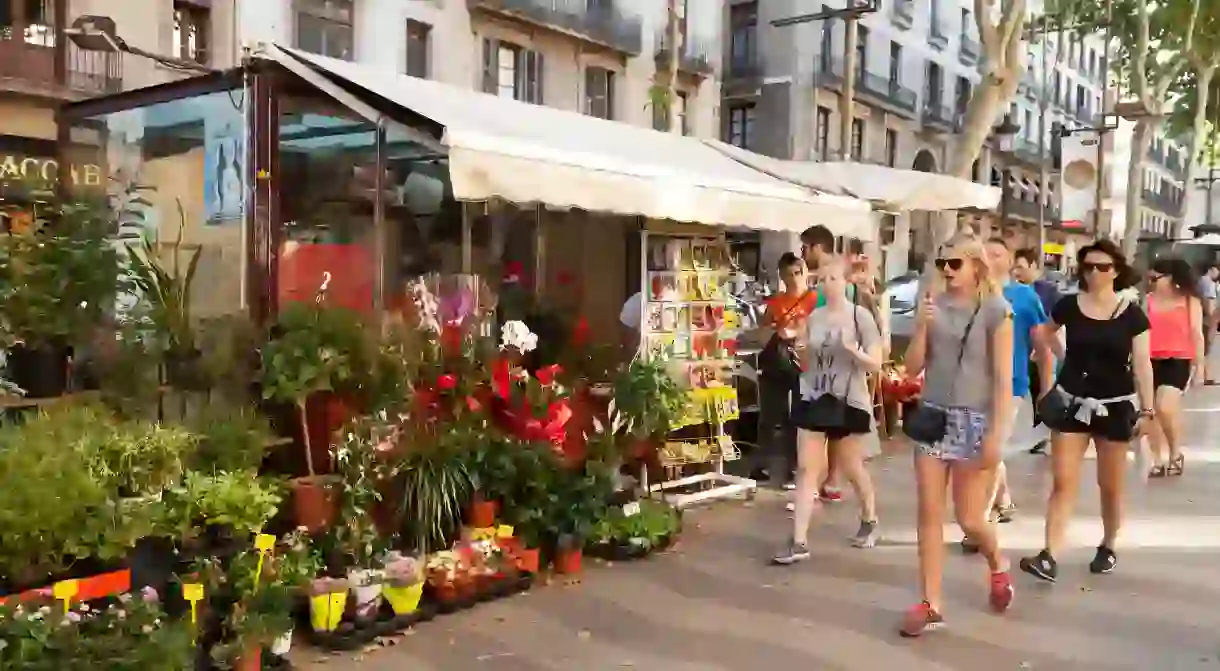Top Things to Do Around Las Ramblas, Barcelona

While you’re in Barcelona, it’s inevitable at some stage that you’ll wind up on the chaotic, touristy yet fun Las Ramblas. It whirrs with atmosphere, and there are many attractions in the vicinity. Here’s our pick of things to do along the most famous street in the Catalonian capital.
This famously chaotic thoroughfare teems with pedestrians sauntering lazily, laughing at the ‘living statues’ and stopping for caffeine-hit cafe con leche (milky coffee) at terrace tables along the way. Sure it’s touristy – they say that if you’re a visitor you walk along it, if you’re from Barcelona you cut across it – but it’s still a lot of fun.
Museu de l’Erotica
Museum

Miró mosaic
Art Gallery

So many visitors wander along to the port at the far end without properly looking at what lies all around – and under – them. Take Catalan artist Joan Miró’s circular tile work, crafted by the maestro himself on the very ground beneath your feet. In fact Miró assisted with the construction of Las Ramblas, and so you should pay homage; after all the city was shaped decisively by the 19th- and 20th-century greats who lived and worked here, including architect Antoni Gaudí. To locate Miró’s masterpiece keep your eyes peeled as you near Liceu Metro and Liceu Theatre. Inspect it closely, and you’ll spot the tile that the great man signed.
Walking tour
Architectural Landmark

Human statues
Architectural Landmark

Bike hire
Shop, Store

At Mattia46, on nearby Gran Via de les Corts Catalanes, you can hire a bicycle from as little as €5 a day – with or without crossbar, you choose – and you’ll conquer Las Ramblas so much more effortlessly than on foot. For that paltry sum they throw in a lock as well as a map of Barcelona marked with the big sights and the best routes. Leisurely and broad-avenued, Barcelona is a perfect cyclist’s city and, for us, pedalling through the shady backstreets of edgy Raval, close to Las Ramblas, is an essential weekend experience; as is discovering the stony, atmospheric gothic quarter, on the other side.
Gran Teatre del Liceu
Opera House

La Boqueria
Market

El Corte Inglés
Store, Shop

London has Selfridges, Paris Printemps and New York Macy’s. Spain’s grand department store brand is El Corte Inglés – and the Barcelona outlet commands a whole block on Plaça de Catalunya, at the opposite end of Las Ramblas to the Columbus statue. Dating from the early 1960s – and remodelled along the way – it is a mighty, slightly Brutalist sweep of concrete, lit prettily after dark. What can you buy here? It might be easier to list what you can’t, as this multistorey shrine to consumerism sells the lot, including perfumes, shoes, furniture and fashion. You can change money, and the food hall in the basement is heaven for collectors of tins from around the world – the vivid cans of Ortiz sardines are attractive enough to give as gifts back home.
A bite to eat
Cafe, Spanish

Despite centuries of change along its length, Las Ramblas has held on to some photogenic and historic dining establishments that deserve your time and your camera-lens focus. For starters, make a date with Cafè de l’Òpera, which has been run by the present owners since 1928, and managed to keep turning out flavourful food even during the Spanish Civil War (1936-39). Come for teas, tapas, beer and a whole array of whiskies. And duck into Pasteleria Escribà – arguably the most famous patisserie in town – for a morning coffee and a croissant as you watch the world go by.
Centre d'Art Santa Mònica
Art Gallery

You can’t leave Barcelona without a stash of memories of its abundant art and architecture, which proliferates city-wide. Las Ramblas is no exception. Among the beautiful galleries in the vicinity lies the Centre d’Art Santa Mònica (CASM). Opened in 1988 in time for the city’s Olympic-era renaissance in 1992, it’s a spectacular space – formerly a convent. The Renaissance cloister within is a fine place to idle when you need a breather from the exhibits. Artists from around the world are featured. All that, and there’s an attractive cafe-restaurant with an open-air terrace.
Barcelona Museum of Contemporary Art (MACBA)
Museum

Christopher Columbus monument
Memorial

Boadas
Bar, Tapas, Spanish, Beer, Wine, Cocktails, Pub Grub

Oozing art-deco elegance, this 1930s wedge-shaped sliver of a cocktail bar is Barcelona’s coolest – and oldest. On a side street just off La Ramblas, it was founded by a barman who learnt his trade at Hemingway’s Floridita Bar in Havana. Who can out-cool that? Smart barmen sport tuxedos as, elegantly, they mix and pour traditional combinations behind the sexy curve of the brass-and-dark-wood bar. It always feels like a secret – particularly if you slip in during the day for a cheeky mojito or three.
The Rambla del Raval
Architectural Landmark

Remodelled in the late ’90s/early 2000s in the heart of the formerly down-at-heel Raval area, this is now a vast and lovely palm tree- and cafe-lined plaza, lozenge-shaped, with a weekend craft market and plenty of people-watching opportunities. To the far end, the enormous Cat by Fernando Botero looks happy enough to be here, sporting a huge smile on his face. At dusk, head up to the roof bar of the hotel Barceló Raval – which dominates the area like a huge, black, metal drum – for excellent margaritas al fresco, and wraparound city views.
The Basílica of Santa Maria del Pi
Church

Jo Fernandez-Corugedo contributed additional reporting to this article.













